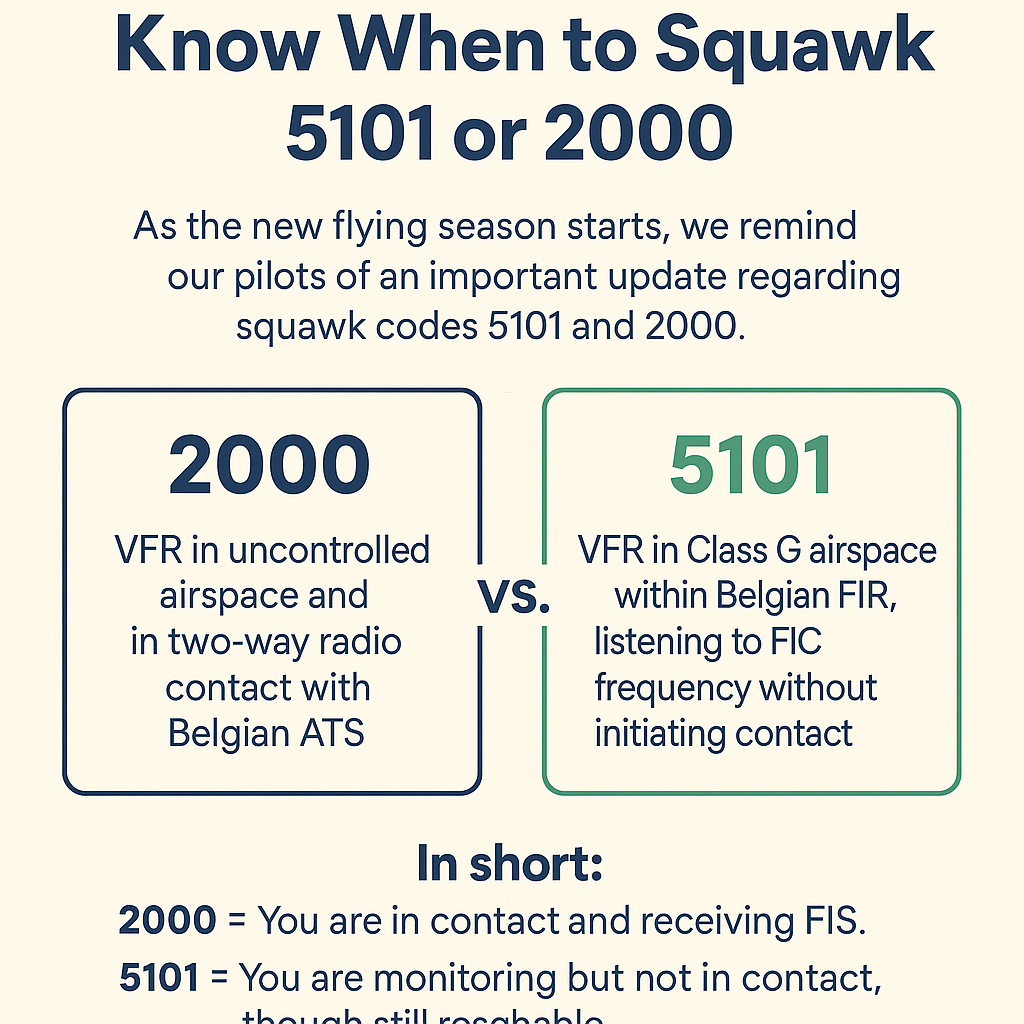
As the new flying season starts, AOPA Luxembourg remind our pilots of an important update in Belgian airspace procedures. Since September 7th, 2023, skeyes (the Belgian air navigation service provider) has implemented a Frequency Monitoring Code (FMC) — squawk 5101 — to improve airspace safety and reduce congestion on flight information service (FIS) frequencies.
Why This Change?
During busy flying days, especially in summer and on good-weather winter days, the Flight Information Service (FIS) in Belgium can become saturated. With limited capacity and a large volume of VFR traffic, providing quality service to all users becomes increasingly difficult.
This saturation has led to airspace infringements and safety-related events. The introduction of FMC 5101 helps alleviate this by allowing pilots to listen to the FIS frequency without making a radio call, while still remaining reachable by ATC.
How It Works
When VFR pilots flying in Class G airspace within the Belgian FIR (excluding Luxembourg) squawk 5101, it tells ATC:
- The pilot is monitoring the FIC (Flight Information Centre) frequency.
- The aircraft is reachable via radio, if needed.
This enables blind transmissions by FIS officers when a pilot appears to be infringing or is near controlled airspace, with the benefit that Mode S transponders also display the aircraft’s callsign on radar screens.
Important: FMC 5101 is for Mode S transponder-equipped aircraft only.
When to Use 2000 vs. 5101
- Use squawk 2000 when you are flying VFR in uncontrolled airspace and are in two-way radio contact with a Belgian ATS unit (e.g. Brussels Info). This code indicates you are receiving a flight information service and are actively communicating with ATC.
- Use squawk 5101 when flying VFR in Class G airspace within the Belgian FIR (excluding Luxembourg), and you wish to listen to the Brussels Info frequency without initiating contact. This is ideal if you’re not requesting flight information services but want to stay reachable and contribute to safer, more efficient frequency use.
In short:
2000 = You are in contact and receiving FIS.
5101 = You are monitoring but not in contact, though still reachable.
Benefits of FMC 5101
- Reduces frequency congestion.
- Lowers workload for both pilots and FIS officers.
- Improves situational awareness and airspace safety.
- Allows immediate emergency calls if needed.
- Supports proactive deconfliction through blind traffic alerts.
Key Codes in the Belgian FIR
| Code | Meaning |
|---|---|
| 7000 | VFR, not in contact with any ATS unit |
| 2000 | In two-way communication with an ATS unit |
| 5101 | Monitoring FIC frequency, reachable, not receiving FIS |
FAQs for Pilots
- Can I enter controlled airspace with 5101?
➤ No. FMC does not grant clearance to enter controlled airspace. - Am I receiving FIS when squawking 5101?
➤ No. You must request FIS and squawk 2000. - Can I declare an emergency while on 5101?
➤ Yes. You are monitoring and can call FIC immediately. - Do I need to inform FIS before changing frequency or leaving FIR?
➤ No. Simply change from 5101 to 7000 or another appropriate code. - Can I use FMC 5101 outside the Belgian FIR?
➤ No. FMC 5101 is strictly for use inside the Belgian FIR, Luxembourg excluded. - Can I report “traffic in sight” if I recognize myself in another aircraft’s traffic information?
➤ Yes. That enhances safety for everyone monitoring the frequency.
AOPA Luxembourg Encourages Best Practices
We recommend AOPA pilots adopt FMC 5101 when flying in uncontrolled airspace below Brussels TMA or near controlled zones. It is a practical tool that enhances safety, reduces ATC workload, and supports good airmanship.
Fly smart. Stay safe. Squawk appropriately.


